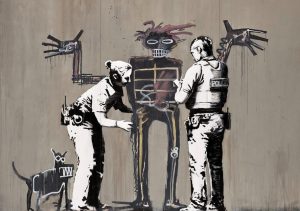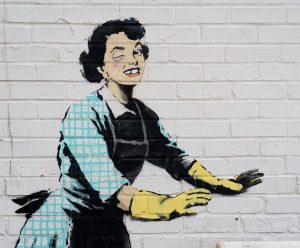Kissing Coppers

Kissing Coppers
Year: 2004
Location: Brighton, England
Kissing Coppers portrays two British policeman kissing. It was originally unveiled on the wall of the Prince Albert Pub in Brighton in 2004.
The two police officers are painted in black and white. Both individuals are shown in full uniform with evident handcuffs and a baton around their respective belts. This portrayal of same-sex intimacy is a common feature of art dating as far back as the 16th century in Michelangelo’s Sistine Ceiling.
Another significant element of Kissing Coppers is its strategic placement. Location is a crucial component of Banksy’s work as it oftentimes adds additional information concerning the message. This mural was realized in Brighton, which is a lively neighborhood, and has been referred to as the LGBT Capital of the UK. In addition, the city is home to the UK’s largest pride celebration each year. Brighton’s rich history with the LGBTQ community dating as far back as the Napoleonic Wars in 1803, has allowed Kissing Coppers to become a cultural staple of the city and its unique population
The evocative piece received considerable damage due to repeated vandalism. These attacks were indicative of the country’s attitude toward homosexuality at the time with London police reporting a 28% increase in homophobic hate crimes over the previous four years as of 2011.
Due to the consistent damaging assaults to Kissing Coppers, Prince Albert Pub decided to have the piece removed and transferred to canvas, replacing it with a replica in 2008.
The owner of the pub, Chris Steward, ultimately made the decision to sell the original.
The sale occurred in February of 2014 at an auction in Miami, where it sold for $575,000,
There was considerable backlash resulting from the sale. Many argued against the Pub’s decision advocating that the removal of Kissing Coppers was not only a devastating loss for the vibrant community of Brighton, but also a hypocrisy to the purpose of street art.
Banksy, as a widely known and admired artist, could easily just create and sell his work privately for considerable sums of money, but instead he continues to pursue public street art. Therefore, some scholars see it as a wrongdoing to privatize what is deliberately meant for the masses.



